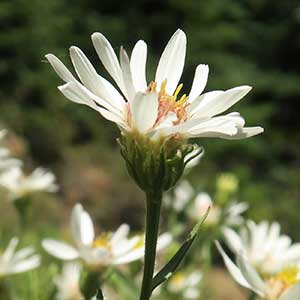Eucephalus paucicapitatus
Eucephalus engelmannii
Olympic mountain-aster
Engelmann's aster, Engelmann's mountain-aster
ascending to erect, pilose or glandular-pubescent.
ascending to erect, glabrate or pilose, eglandular to ± densely glandular.
mid and distal blades elliptic to elliptic-oblong, 2–4 cm × 4–13 mm, sparsely scabrous to stipitate-glandular abaxially, moderately stipitate-glandular adaxially.
mid and distal blades elliptic to lance-ovate, 5–10 cm × 15–35 mm, faces glabrous and eglandular to adaxially villous and/or ± glandular.
stipitate-glandular.
often stipitate-glandular.
turbinate-obconic, 7–9 mm.
turbinate, 7–10 mm.
in 2–3 series (whitish), lance-linear (unequal), apices acute, abaxial faces stipitate-glandular.
in 4–6 series (strongly unequal, often reddish apically), linear to lance-ovate, acute to acuminate, pubescent to glandular or glabrate abaxially, villous adaxially, especially distally (appearing ciliate toward tips).
usually 2–4 in racemiform to corymbiform arrays, somtimes borne singly.
5–15(–40) in racemiform to corymbiform arrays.
obconic, pilose;
pappus bristles in 2 series, ± barbellate.
usually pilose;
pappus bristles in 2 series, barbellate.
7–13(–21), white.
usually 8 or 13, white to pink.
= 18.
Eucephalus paucicapitatus
Eucephalus engelmannii
Eucephalus paucicapitatus is found on Vancouver Island, where it is very uncommon, and the Olympic Peninsula. It is closely related to E. gormanii.
(Discussion copyrighted by Flora of North America; reprinted with permission.)
Forms of Eucephalus engelmannii from the Cascade Mountains with leaves more densely pubescent on the abaxial faces may reflect intergradation with E. ledophyllus.
(Discussion copyrighted by Flora of North America; reprinted with permission.)


